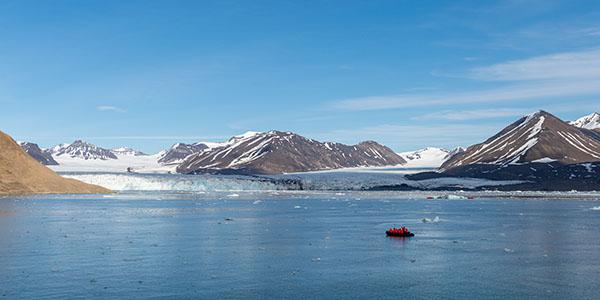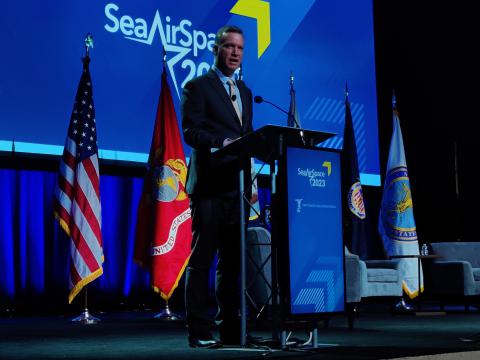The National Security Implications of Climate Change
Leaders need to be aware of how climate change is affecting the United States and other nations, how countries will handle the impacts, and how that might change the geopolitics and power balance across the world. Already, near-peer adversaries, including China and Russia, are capitalizing on climate change, experts say.
For example, because of climate change, the Arctic has melting and thinning ice. For the intelligence community, strategic analysis of shifting routes, travel and operations in the Arctic Sea region is necessary, said David Titley, professor, International Affairs and professor, Practice, Department of Meteorology, and director, Center for Solutions to Weather and Climate Risk, Pennsylvania State University.
Titley; Sherri Goodman of the Wilson Center's Environmental Change and Security Program and Polar Institute, and former deputy undersecretary of defense, environmental security; John Conger, director, The Center for Climate and Security; Erin Sikorsky, deputy director, Strategic Futures Group, National Intelligence Council (NIC); and moderator Greg Treverton, professor, practice of international relations and spatial sciences, University of Southern California, discussed the risks of climate change to national security during a panel session of the 2020 Intelligence and National Security Summit. The annual event was co-hosted virtually by AFCEA and the Intelligence and National Security Alliance (INSA) from September 16 to 18.
Dr. David Titley, professor @penn_state: For decades, there have been incentives in academia to try & overturn any notion that climate change is happening, but the more and more we research, what we understand is: we are warming due to greenhouse gasses #intelsummit20 pic.twitter.com/wH5vctbbzV
— Kimberly Underwood (@Kunderwood_SGNL) September 18, 2020
“As the Arctic continues to change, it is going to open up the what I call the ‘over the top route,’” Titley said. “And what’s going to be the most strategic, I think, are places like Dutch Harbor, Deep Water Point, which is near the existing Trans-Pacific shipping routes. But you can also look at both the Faroe Islands and Iceland, which can be a terminus and potentially a bridge.”
Russia, which is increasing its operations in the Arctic Sea, has 40 ice breaker vessels, many of which are nuclear powered, a big contrast to the United States’ infrastructure, said Goodman.
“We are absolutely under-capitalized in icebreakers,” she said. “We have an icebreaker gap, and not only that, but one of our two aging icebreakers had a fire onboard this summer, so the annual mission was cut short. And our icebreakers have to serve Antarctica as well as the Arctic because they provide assistance to the Antarctic science mission. There is a plan to ultimately build six new icebreakers and three medium vessels in the next five plus years, but we are still in a gap.”
Sherri Goodman @CntrClimSec & former DUSD for Environmental Security: Environmental degradation and security implications of climate change are now a higher priority in intel community and DOD, as leaders know no region of the world is immune #intelsummit20 @INSAlliance @AFCEA pic.twitter.com/PH76Qn5Pek
— Kimberly Underwood (@Kunderwood_SGNL) September 18, 2020
And while the Air Force released in July its first-ever Arctic strategy to expand the presence needed to deter missile and other threats in the high north, “we need to have more ability to operate at the surface,” she said. And that involves not only the U.S. Coast Guard but also the Navy's ability to operate. Titley also recommended that U.S. leaders also consider less costly “ice capable” vessels—like Finland has done.
China, meanwhile, is posturing itself to be able to not only survive climate change but also dominate in a world weakened by its impacts, Conger emphasized.
“I think if you look at China's behavior through a climate change lens, a lot more of their activities make more sense,” he stated. “Why are they going and trying to take advantage of the resources in the Arctic? Why are they exerting influence over the fish supplies in the South China Sea? Where are they exerting influence over food supplying nations in Africa? They are finding ways to ensure they're going to continue to have food and water and influence the region. And they are continuing to admit twice of our emissions, and we're not going to solve climate change without them reducing dramatically or us reducing dramatically.”
On the domestic front, the U.S. military increasingly has had to confront substantial direct impacts from climate change, Conger continued. Just in the last few years, impacts from severe weather, river flooding, hurricanes and extreme rain have cost the U.S. military $10 billion.
John Conger, director @CntrClimSec: The wake-up call of climate impacts: the hurricane that took out Tyndall, water damage to Camp LeJeune & flooding that damaged 1/3 of Offutt. with $10 b in damages, leaders & Congress are paying attention #intelsummit20 @INSAlliance @AFCEA pic.twitter.com/Wc92WVc8zI
— Kimberly Underwood (@Kunderwood_SGNL) September 18, 2020
“I often get asked why the military would even care about climate change in the first place,” he shared. “It is because it affects your mission today, that is your installations, your readiness and that is today's operations. Climate change is definitely affecting all of those aspects.”
Sikorsky advised the intelligence community to consider the interdependence of the world when conducting analysis about climate change. “Very rarely is a climate issue the sole driver behind a security threat,” she offered. “It is the intersection of climate with other developments and with other trends and issues that combine to increase the risks.”
When evaluating risks of climate change to national security, intelligence analysts should leverage the expertise across the U.S. government as well as accurately measure how countries manage climate risk, Sikorsky advised.
Erin Sikorsky, National Intelligence Council @ODNI_NIC: the intel community has warned of the national security risks of climate since 1996. We see the indirect, compounding effects impacting even highly-developed counties for decades to come #intelsummit20 @INSAlliance @AFCEA pic.twitter.com/6CjqbYyWVm
— Kimberly Underwood (@Kunderwood_SGNL) September 18, 2020
“We need to understand how to measure resilience in other countries,” she emphasized. “And as we've seen with the pandemic, it's not always material power that matters, but the tangible and intangible things related to adaptability, flexibility, the ability to absorb shocks, and it's those intangibles like trust, societal cohesion and history that I think will make all the difference for understanding which countries are better positioned to manage climate risks going forward. And so, we in the intelligence community need to understand and think about that.”






Comments